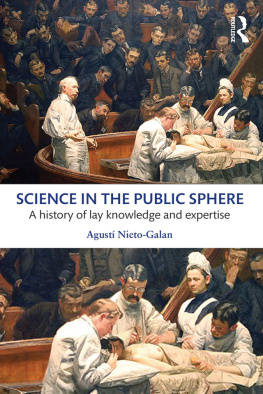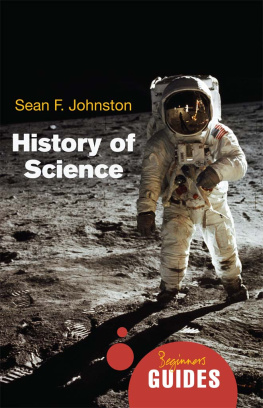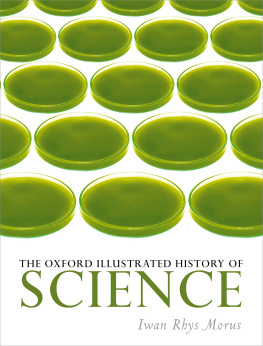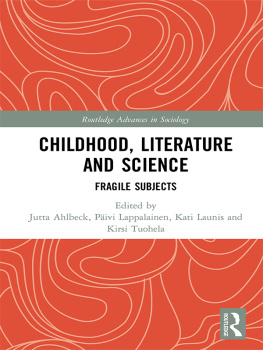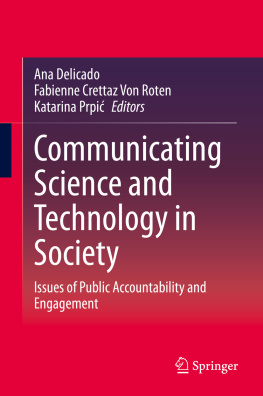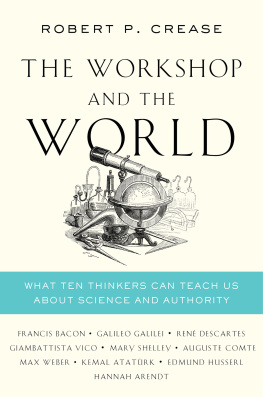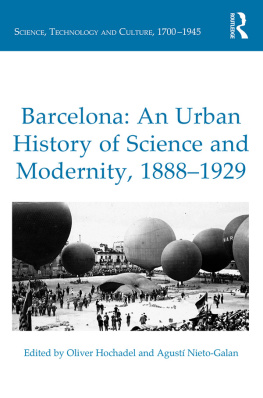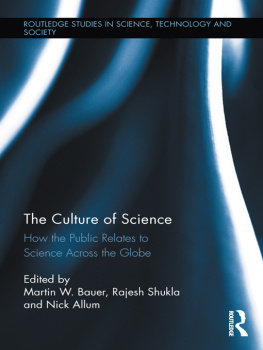Science in the Public Sphere
Science in the Public Sphere presents a broad yet detailed picture of the history of science popularisation from the Renaissance to the twenty-first century. Global in focus, it provides an original theoretical framework for analysing the political load of science as an instrument of cultural hegemony and giving a voice to expert and lay protagonists throughout history.
Organised into a series of thematic chapters spanning diverse periods and places, this book covers subjects such as the representations of science in print, the media, classrooms and museums, orthodox and heterodox practices, the intersection of the history of science with the history of technology, and the ways in which public opinion and scientific expertise have influenced and shaped one another across the centuries. It concludes by introducing the participatory turn of the twenty-first century, a new paradigm of science popularisation and a new way of understanding the construction of knowledge.
Highly illustrated throughout and covering the recent historiographical scholarship on the subject, this book is valuable reading for students, historians, science communicators and all those interested in the history of science and its relationship with the public sphere.
Agust Nieto-Galan is Associate Professor of History of Science and Director of the Centre dHistria de la Cincia at the Universitat Autnoma de Barcelona. He has written widely on the history of chemistry and natural dyestuffs, and on the history of science popularisation (eighteenth to twentieth centuries). His publications include Barcelona: An urban history of science and modernity: 18881929 (co-editor, 2016) and Popularizing Science and Technology in the European Periphery, 18002000 (co-editor, 2009).
Science in the Public Sphere
A history of lay knowledge and expertise
Agust Nieto-Galan
Translated by Fiona Kelso
Published in English in 2016
by Routledge
2 Park Square, Milton Park, Abingdon, Oxon OX14 4RN
and by Routledge
711 Third Avenue, New York, NY 10017
Routledge is an imprint of the Taylor & Francis Group, an informa business
2016 Agust Nieto-Galan
Translated into English by Fiona Kelso
The right of Agust Nieto-Galan to be identified as author of this work has been asserted by him in accordance with sections 77 and 78 of the Copyright, Designs and Patents Act 1988.
All rights reserved for the English edition. No part of this book may be reprinted or reproduced or utilised in any form or by any electronic, mechanical, or other means, now known or hereafter invented, including photocopying and recording, or in any information storage or retrieval system, without permission in writing from the publishers.
Trademark notice : Product or corporate names may be trademarks or registered trademarks, and are used only for identification and explanation without intent to infringe.
First published in Spanish in 2011 with the title Los pblicos de la ciencia:
Expertos y profanos a travs de la historia
by Marcial Pons, Ediciones de Historia, S.A.
San Sotero, 628037 Madrid
British Library Cataloguing in Publication Data
A catalogue record for this book is available from the British Library
Library of Congress Cataloging-in-Publication Data
Names: Nieto-Galan, Agust.
Title: Science in the public sphere : a history of lay knowledge and expertise / Agust Nieto-Galan.
Other titles: Publicos de la ciencia. English
Description: Abingdon, Oxon : Routledge, 2016. | First published in Spanish in 2011 with the title: Los pblicos de la ciencia : expertos y profanos a travs de la historia (Madrid : Marcial Pons, Ediciones de Historia). | Includes bibliographical references and indexes.
Identifiers: LCCN 2015033056 | ISBN 9781138909519 (hardback : alk. paper) | ISBN 9781138909526 (pbk. : alk. paper) | ISBN 9781315640747 (ebook)
Subjects: LCSH: Communication in science. | ScienceSocial aspects. | Science news.
Classification: LCC Q223 .N4813 2016 | DDC 500dc23
LC record available at http://lccn.loc.gov/2015033056
ISBN: 978-1-138-90951-9 (hbk)
ISBN: 978-1-138-90952-6 (pbk)
ISBN: 978-1-315-64074-7 (ebk)
Typeset in Bembo
by Apex CoVantage, LLC
To the memory of Rosa Ambrs Barbany (190089), a wise lay woman
Contents
This book is the outcome of a long intellectual journey. It came into being in April 1994 in the Modern History Faculty at the University of Oxford, in a History of Science graduate seminar. There, at the heart of British academia, in the land of Isaac Newton, Charles Darwin and Michael Faraday, among other great names in Western science, I heard about popular science and scientific culture for the first time; I decided to revive and learn about not only the great luminaries from the past but also those who were lay, ignorant, forced aside from the epic struggle to explain the supposed truths of nature. At this informal gathering, someone mentioned an article published that same year by historians Roger Cooter and Stephen Pum-phrey. Despite the difficulty of reading it and the dense web of ideas it contained, the paper made a deep impact on me and led me to question the meaning of my work as a historian of science and to wonder about the ultimate reasons to ask certain questions of the past instead of others.
A few weeks later, my current colleague, Dr Xavier Roqu, who at that time held a post-doctoral position at the University of Cambridge, told me about the recent publication of a history of the science displayed at the nineteenth-century worlds fairs, especially Londons famous Great Exhibition held in 1851. It was a work by historian Robert Brain, which contained amazing engravings of the Crystal Palace and some of the pavilions that housed machinery, inventions and scientific instruments in London, and also in Paris, Vienna, Chicago and Philadelphia.
Never before had I seriously considered the possibility of examining the history of science from the perspective of entertainment, fairs or popular culture, or from the plural perceptions of its multiple actors. Furthermore, back then I was particularly interested in the role of artisans, as crucial actors in the history of technology, but often forgotten in the romantic mythology of the great inventors, along with professional scientists and engineers working under the aegis of their academic institutions.
Some ideas need a long time to ripen, to slow-cook in the deepest recesses of our minds. Focusing on science in the public sphere I will return to this concept later means to make old research topics useful and to dive into the abyss of a new field yet to be explored. So these first fascinating readings hibernated for ages in the messy drawer of disjointed musings, on the lists of good intentions that we all jot down in our notebooks during lulls in the maelstrom of everyday academic life.
In the summer of 2003, once I had finished my work on the craftsmanship skills of eighteenth- and nineteenth-century European dyers and printers, my seminal fascination for science in the public sphere resurged. It was during my stay at the Universit de Paris X, Nanterre, when I spent many glorious days at the Biblio-thque nationale de France reading and rereading papers and books by authors that have become close friends in my teaching and research activities and who play a crucial role in the chapters of this book.

